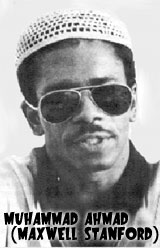In America’s onslaught against Blacks, when it dawned on some in the African-American community that long marches and pleadings to be treated right was not heading anywhere, the Revolutionary Action Movement (RAM) emerged to defend Blacks.
RAM also countered violence with force.
The RAM was organized in 1963 by a group of black people who advocated militant self-defense as a means of dealing with white racism.
RAM was founded by young activists led by Max Stanford (Muhammad Ahmad) and Robert Franklin Williams. RAM articulated a revolutionary program for Black Americans that fused Black Nationalism with Marxism-Leninism. Its goal was to develop revolutionary cadre in the northern cities and connect with more militant students in the south. RAM supported the movement by SNCC and others for armed self-defense for southern Blacks terrorized by the Ku Klux Klan, as well as, provided security for Malcolm X after his break from the Nation of Islam.
In 1964, a manifesto was issued setting forth the objectives and program of the organization. The objectives included:
1. Instilling in Black people a sense of pride, dignity, unity, and solidarity in struggle;
2. Bringing about a new image of manhood and womanhood among Black people;
3. Freeing black people from colonial and imperialist bondage everywhere taking whatever steps may be necessary to achieve this goal;
4. Inculcating a sense of purpose in Black people.
RAM saw all the non-white people of the world as enslaved by the same force, namely white capitalism. Hence, revolutionary nationalism became internationalism. The government of the United States was seen as the enemy of freedom and self-determination throughout the world.

RAM demanded that the United States be partitioned into two separate states, one for Blacks and one for whites. The Black Nation to result from this partition consisted of the nine states of Mississippi, Louisiana, Alabama, Georgia, Florida, Texas, Virginia, South Carolina and North Carolina. This land rightfully belonged to Black people, they maintained, because Black slave labor cultivated it for centuries. In addition to this territory, the leaders of RAM demanded an unspecified sum as a form of reparations for racial crimes against black people historically.
Finally, RAM believed that Black people must arm themselves for the inevitable revolution. Their definition of revolution was “… one group’s determination to take power away from another.”
The group operated as a semi-clandestine organization because of its arms bearing. Malcolm X joined forces with RAM with the organization becoming the paramilitary wing of the Organization of Afro-American Unity (OAAU) – a Pan-Africanist organization founded by Malcolm X in 1964.
Ram was a precursor to the Black Panther Party. Its leader, Stanford was a close associate of Malcolm X. They had discussed how to use RAM’s force to protect civil rights leaders like the Rev. Dr. Martin Luther King Jr. RAM also provided security for Malcolm X after he separated from the Nation of Islam. Key leaders associated with RAM included Malcolm X, Robert F. Williams, Amiri Baraka and Assata Shakur.
RAM operated from Philadelphia and New York claiming several hundred members including teachers, students, clerks, and business people all of whom were passionately dedicated to the struggle of which they were a part.
Their goal included building a liberation army by educating and mobilizing young African Americans through grassroots organization to maintain a base in the Black community. The organization published a bimonthly magazine, Black America, and distributed a free weekly titled RAM Speaks. RAM also sent out field organizers to form local groups, organize street meetings, and hold African and African-American history classes.

Despite its small size and relative obscurity, RAM’s militant posture and commitment to grassroots organizing made it a target of Federal Bureau of Investigation (FBI) infiltration. RAM became one of the first casualties of the FBI’s Counter-Intelligence Program (COINTELPRO).
“By 1965, as part of a larger program to undermine radical black organizations, undercover FBI agents had penetrated RAM’s structure. On June 21, 1967, New York City and Philadelphia police rounded up seventeen RAM members, including Maxwell Sanford, field chair of RAM, in predawn raids and seized about 130 weapons. Fifteen members were charged with criminal conspiracy, but they were never brought to trial and charges were eventually dropped. The other two, Herman Ferguson, an assistant principal at a New York City school, and Arthur Harris, unemployed at the time, were convicted of conspiracy to assassinate Roy Wilkins of the NAACP and Whitney Young of the National Urban League and sentenced to three and a half to seven years in prison. After failed attempts at appeals, Harris fled to Sweden, where he remains today, and Ferguson went to Guyana, where he lived for nineteen years. Upon returning to the United States in 1989, Ferguson was immediately taken into custody, but he was released on parole in 1993.”
In the spring of 1967, J. Edgar Hoover, head of the FBI, called Max Stanford, RAM’s national field chairman, “the most dangerous man in America.” This was the signal for a national and worldwide manhunt to take off the streets and incarcerate suspected RAM members.
By September 1967, seven RAM members in Philadelphia were charged with conspiring to assassinate local and national leaders, blow up city hall and foment a riot during which time they planned to poison the city’s police force. They denied the allegations and claimed that local police and FBI agents had instituted a frame-up to discredit them.
In 1968, facing repression from the intelligence agencies of the U.S. government, coordinating with local police departments, the national central committee dissolved RAM as an organization.
The group’s political formation deeply influenced the politics of Huey Newton, Bobby Seale, and many other future influential Black Panther Party founders and members.










